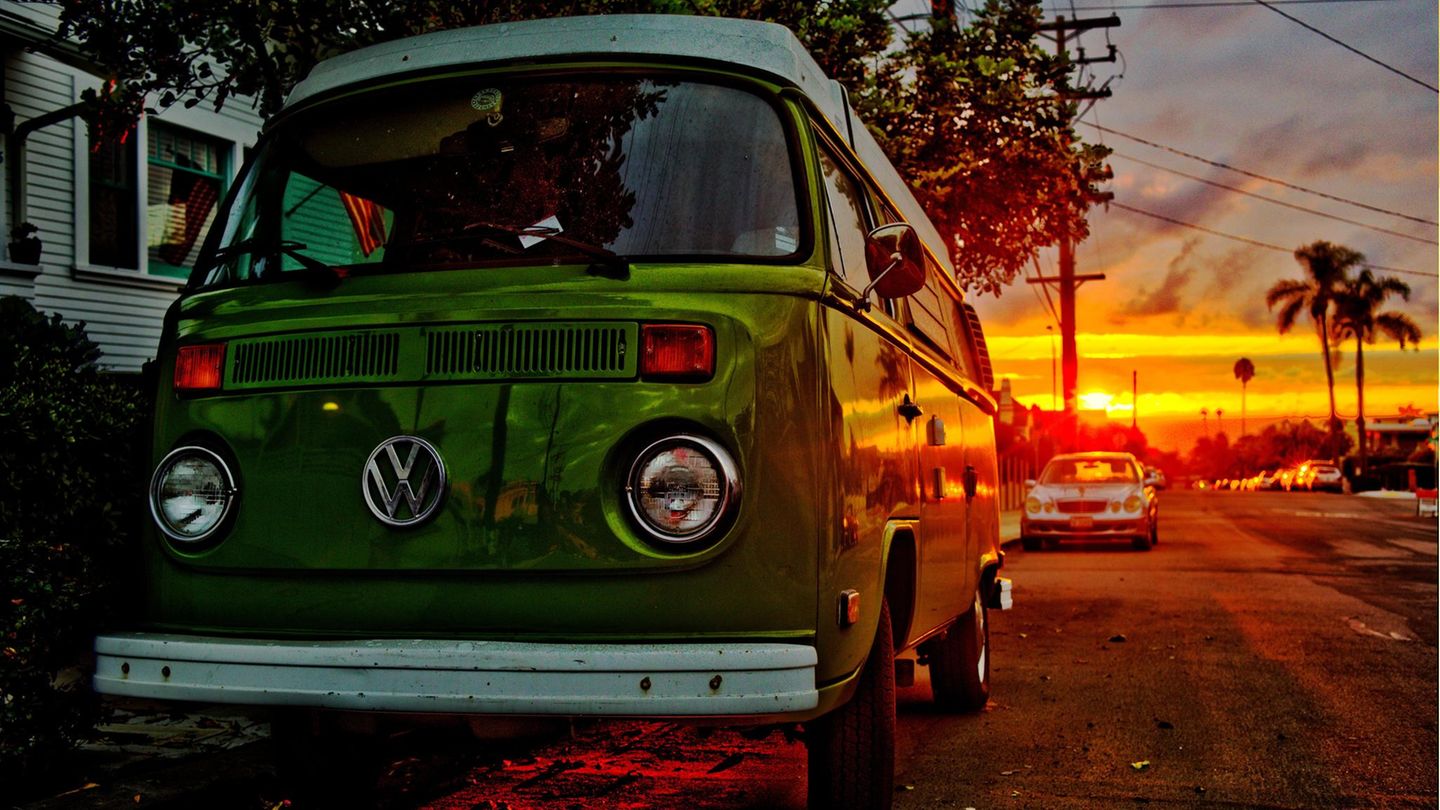Volkswagen is preparing at full speed for the electric ID. Buzz ahead. In the USA in particular, the VW Bulli has been a legend for decades. This should facilitate the launch of the electric model in the coming year.
You don’t have to look far for a VW Bulli on the streets of California. Whether you are on the beach in Malibu, north of San Diego in La Jolla or in the Bay Area – it is difficult to spend a day without seeing one or even more of the legendary Bullis. This applies to the T1 bus as well as to the more modern T3 variants in their Wolfsburg Edition or the less successful Eurovan of more recent year of construction. Americans love their Bulli in a completely different place than in Germany, where they were born, or in their younger home in South America. In Mexico or Brazil, the Bulli is a workhorse – reliable, almost indestructible and easy to repair. It was not until 56 years after the start of production that the Bulli said goodbye to its Brazilian parent plant in São Bernardo do Campo in 2013 with a special edition of 1200 instead of the originally planned 600 vehicles. Ever stricter emissions regulations finally put an end to the successor to the original model from 1957. Volkswagen sold around 26,000 of these in the last year of production, a total of around 1.12 million of the T2 alone in 45 years. That’s enough for a place in the top 10 of the South American registration statistics.
No longer than the disc
The Bulli lost its characteristic boxing sound years ago. Because in the rear of the loadmaster no boxer roared, but a 1.4 liter inline four-cylinder with 78 hp and 125 Nm maximum torque. The 1.3 tonnes curb weight and the less sophisticated aerodynamics of the rear-wheel drive vehicle prevent the performance from differing significantly from those when the T2 was phased out in our part of the world at the end of the 1970s. If you want to, you can go from 0 to 100 km / h in just under 17 seconds. Four gears that are not always easy to engage – there is nothing more. A top speed of 130 km / h requires a good deal of courage, at least on the poor Brazilian slopes. Otherwise you are better off below 100 km /.
His overview remained unbeatable until the end, because where the windows end is the end of the 4.51 meter long car. As usual, there were two flaps at the stern. Behind the upper one you can reach the high-lying hold. Both benches in front of the cargo area cannot be easily folded down under any circumstances. If you need more space, you have to remove the seats with around a dozen screws and store them in the garage. That was the way it was in the unsteady 60s and 70s. But then there are also over 4,800 liters of storage space and a ton of payload available.
Icon of the hippie movement
At first, Volkswagen was rather suspicious of the hippie image of the VW Bulli and, to put it mildly, they weren’t particularly pleased that the VW bus had become an icon of the hippie movement. The staid Wolfsburg feared a negative image. In the end, however, this was cultivated with a lot of diligence and nostalgic feelings. Together with Sony Musik, for example, a CD was created which, under the title “Summer of Love & Peace”, summarizes the catchiest titles of the time. Let’s see what goes best with it when we say goodbye? How about Roger McGuinn: “Knockin ‘On Heave ‘ s Door”? The long-denied hippie image in particular made the Bulli a legend in the USA, from which the successor generation of the T3 also benefited. Now, after the comparatively expensive VW T4, which was sold in the USA as the Eurovan, and the import break for the T5 and T6, there are hopes for positive radiation effects on the electric VW ID. Buzz, because the new T7 will not make the leap across the Atlantic for cost reasons. For years, the T1 and T2 Bullis have been converted into electric vehicles in the USA – the ID. Buzz sends his regards.
In the animated film “Cars”, Disney and Pixar Studios created a monument to the company car of hippie culture with Fillmore. The friendly VW bus always seems a bit too stoned and sells bio-fuel at its alternative gas station. Every morning the old hippie argues with his neighbor Sarge, a decommissioned army jeep, about which music is better to start the day with: military trumpet or Jimmy Hendrix. Fillmore isn’t the only VW Bulli that has made film history. Whenever a car should evoke the urge for freedom and the mobility of the flower power era, a VW bus was usually chosen. He has played a more or less important, but often a major role in over 80 films. And many of the films have become cult themselves: “Alice’s Restaurant” (1969) for example, “Is ‘what, Doc?” (1972), “Breathless” (1983), “Free Willy” (1993), “Forest Gump” (1994), “Jackie Brown” (1997), “Spy Game” (2001), or “Scary Movie 4” ( 2006). In “Futurama”, the second comic series by Simpson inventor Matt Groening, the heroes have a colorful T1 as a tour bus in one episode.
Hollywood helped
The Bulli was not infrequently an important part of film history. In “Little Miss Sunshine”, for example, the T2 is something like the seventh member of the Hoover family, who drive across the southwestern United States to get to a beauty pageant in time. The fact that the timing works is not least thanks to the Bulli, which neither closed parking barriers nor a broken clutch can stop. “Das wilde Leben” (2007), the filmed biography of Uschi Obermeier, is hardly conceivable without a VW bus. The brightly painted Bulli delivers them straight to Munich’s commune 1. Even more than on the screen, the VW bus plays an important role in music – no wonder: at least in their early years, many musicians were constantly on the move with it. Bruce Springsteen sings about him in the song “The Angle” on his 1973 album “Greetings from Ashury Park, NJ”. Years earlier, “The Who” told in “Going Mobile” what it is like to be out and about in a VW bus. Pete Townshend: “The VW bus I wrote about in this song was the rolling hippie home – we all loved it.” The “Fairport Convention” set another monument for the T1 with “Keep on Turning the Wheel”. In Australia, “Down Under” by “Men at Work” has been a cult song since the early 80s – it also alludes to the VW bus. Robbie Williams, for example, shows on his album “I’ve been expecting you” from 2001 that the big emotions are by no means cold today. In the track “Jesus in a Camper Van”, the Son of God tours the country in a VW campervan – almost like the beach surfers of Malibu or the hippies of Venice. Let’s see if that fits the VW ID. Buzz from the country can give a tailwind.
I am a 24-year-old writer and journalist who has been working in the news industry for the past two years. I write primarily about market news, so if you’re looking for insights into what’s going on in the stock market or economic indicators, you’ve come to the right place. I also dabble in writing articles on lifestyle trends and pop culture news.




